AMD's DLSS rival will hopefully be arriving later this year
FidelityFX Super Resolution will be called FSR when it launches
AMD are hoping to launch their answer to Nvidia's AI-driven upscaling DLSS tech later this year, according to a new interview with PC World. DLSS is currently one of the only ways to achieve playable frame rates at high resolutions in games that support ray tracing at the moment, but AMD's version of it, FidelityFX Super Resolution, isn't currently available on any of their next-gen RX 6000 Big Navi GPUs. It's one of the reasons why I was so down on the Radeon RX 6700 XT yesterday in my review, but AMD's Radeon boss Scott Herkelman called FidelityFX Super Resolution (or FSR) one of the "biggest software initiatives we have internally [at AMD]" and that the company "wants to launch it this year". I wouldn't get your hopes up for an imminent release, however, as he also said there's still a lot of work to do before it's ready for primetime.
"It's progressing very well internally in our labs, but our commitment to the gaming community is that it's open, it needs to work across all things, and our game developers need to adopt it and feel like it's a good thing," Herkelman told PC World. "So even though it's progressing well, we've still got more work to do, not only internally but also with our game developer partners.
"You know, we want to launch it this year, we believe we can do that this year, but at the same time we've got a lot more work ahead of us. We need to make sure the image quality is there, we need to make sure we can scale from different resolutions and at the same time that our game developers are happy with what we're producing. So we still have some work ahead of us.
"It's probably one of the biggest software initiatives we have internally because we know how important it is that you want to turn on ray tracing and you don't want to just have that competitive hit, or have your GPU get hit so hard. So FSR, that's the acronym for FidelityFX Super Resolution, is something key to us to launch this year, but it's going to take a little bit more time."
It's a shame AMD have been so late to the party with FSR, and Herkelman's answer above is pretty much a variation on what AMD told me during the run-up to the launch of their new Radeon RX 6700 XT. When I asked for an update on when it's likely to be released, AMD said, "We continue to expand our collaborations with game developers on the development of an upscaling feature for AMD Radeon graphics cards that can be easily implemented across a broad selection of titles," and that they'll release more information at a later date.
Indeed, as I posited in my RX 6700 XT review yesterday, it would appear that getting developer support for FSR is one of the key issues holding it back from release at the moment, and the longer AMD go without having FSR available to help improve frame rates when ray tracing is enabled, the more harmful it's going to be to their subsequent GPU releases when it comes to overall value for money. I've tested several ray tracing games now such as Watch Dogs Legion and The Medium that are pretty much unplayable without the aid of Nvidia's DLSS tech, and some games such as Cyberpunk 2077 have it enabled by default when you switch over to their ray tracing quality presets.
DLSS has come a long way since it first launched alongside Nvidia's RTX 20 series cards, too. It works in a similar fashion to the PlayStation's checkerboarding techniques, rendering the game at a lower resolution, and in the case of DLSS, using AI to fill in the blanks once it's been upscaled to your target resolution. The first iteration of DLSS often left games looking a bit smudgy compared to what they looked like at their native resolutions, but the AI gubbins behind the latest version, DLSS 2.0, has come on leaps and bounds. In Death Stranding, for example, I was hard-pushed to tell the difference between having DLSS turned on and off, and when the performance boost it provides can pretty much turn any RTX card into a 4K 60ps machine, you'd be daft not to enable it if you had the option.
Performance does vary between games, of course, but there's no denying that DLSS is one of the only things that makes real-time ray tracing even vaguely achievable at the moment, and if AMD want their RX 6000 GPUs to compete on a level playing field in this regard, FSR can't come soon enough.


